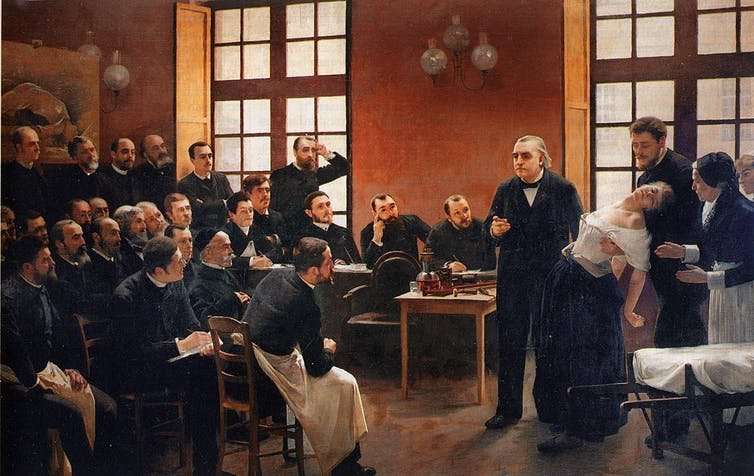Charcot demonstrating hypnosis on a hysterical patient. Credit: André Brouillet/Wikimedia Commons
A 35-year-old woman loses the use of her legs, suddenly becoming paralysed from the waist down. In another case, a woman feels an overwhelming compulsion to close her eyes, until eventually she cannot open them at all. After numerous tests, nothing physically wrong was found with these patients, so what caused their symptoms?
Conditions like these used to be diagnosed as hysteria. In fact, they would fit neatly into the pages of Sigmund Freud and Josef Breuer's Studies On Hysteria, written over a century ago.
You might think our understanding has advanced since Freud, or, rather more fashionably, that Freud was just wrong. But this isn't the case.
The term hysteria was dropped when the influence of a psychodynamic theory of mental ill health, with its concepts of unconscious mental forces affecting behaviour, fell out of favour in psychiatry. But while they turned to more measurable features and symptoms, the condition remains in what is now called "conversions disorder".
It was Freud who proposed that the memory of trauma which the patient fails to confront, because it will cause them too much mental anguish, can be "converted" into physical symptoms. What is more surprising is that cases like this are typical of those routinely seen by neurologists today.
For example, the case of the 35-year-old woman (Ely), noted above, is given in Gordon Turnbull's Trauma, a book on the history and treatment of post-traumatic stress disorder. After X-rays for a bleed in Ely's spinal cord came back negative, Turnbull tried a lumber puncture to extract fluid. Ely didn't even wince as the needle went in. She seemed indifferent to her sudden paralysis. The nurses thought she was putting it on.
Perplexed, Turnbull's mind "suddenly jumped to Freud", who he recalls said that mental conflict could become physical disability.
On interviewing Ely, he eventually discovered that she had been raped by someone she knew. This caused the unbearable mental conflict that was "converted" into her physical symptoms. She evidently knew this, but had pushed its significance out of her conscious awareness to protect herself. She found that talking her experiences through repeatedly was cathartic – her pent up feelings were released. Two days later, she was able to leave the hospital, unaided.
The women (Mary) who felt compelled to shut her eyes is one of many cases described by the neurologist Suzanne O'Sullivan in It's All In Your Head. Her husband was on remand for child abuse, but she refused to think this might be an important factor in her illness. Treated with muscle relaxant drugs, she soon recovered. But a month later, she was readmitted, suffering from amnesia. Brain scans and an EEG were normal, but a neighbour told O'Sullivan that her husband had been released from prison. O'Sullivan is left wondering what this patient "could not bear to look upon" or "tolerate to remember".
Despite the many new technical means of investigation, researchers have very little to offer beyond Freud to account for how psychological and emotional experiences manifest in physical symptoms. O'Sullivan writes that:
"… for all the shortcomings in the concepts proposed by Freud and Breuer in Studies, the twenty-first century has brought no great advances to a better understanding of the mechanisms for this disorder."
Publicly acknowledged, at last
This is acknowledged more publicly now. For example, the neurologist Richard Kanaan in BBC Radio 4's All In The Mind states that Freud still "looms quite large in our repertoire of explanations". In fact, it would be a very small repertoire if you excluded Freud.
Since we can use sophisticated medical testing, we now know that it is not the neurological "hardware" that is damaged, so it must be the "software", our psychological response to the meaning of trauma, that leads to conversion disorder.
Freud originally studied anatomy and neurology and wrote notable papers, some of which are still considered classics today, such as On Aphasia. But it was the limitations inherent in the brain sciences of his day that led him to develop a more psychological map of the mind.
In a radical departure from the practice of the day, which either paraded hysterical patients around at public demonstrations – as the French neurologist, Jean-Martin Charcot did – or treated them as malingerers, Freud sat his patients down and listened attentively to them. After ten years of this practice, Freud came to believe that behind every hysterical symptom, such as convulsions, paralysis, blindness, epilepsy, amnesia or pain, lay a hidden trauma or series of traumas.
In his many case examples, Freud carefully traces these initially hidden traumas. His accounts in Studies On Hysteria would still make exemplary reading for those working with conversion disorder patients today who also deserve to be listened to.
While conversion disorder has attracted suspiciously little academic attention, what research has been done tends to confirm Freud.
In 2016, researchers discovered that patients with conversion disorder had experienced a greater number of stressful life events than other people, and a dramatic increase in these events near to the time when their symptoms began.
This profile fits many of the cases described by Freud in Studies On Hysteria. For example, Katherina's breathing difficulties and visions of a frightening face staring at her, came on after witnessing her father sexually abuse her cousin. The research also found that in some patients no stressors were identified, but one wonders if this is only because few researchers can replicate Freud's skillful picking up of clues in his patients' "free associations"?
Freud's brilliance was in recognising that disturbing memories don't just go away. His compassion lives to this day in the method he established for bringing them to light and reducing their negative and sometimes debilitating effects: psychoanalysis.
Provided by The Conversation
This article was originally published on The Conversation. Read the original article.![]()























